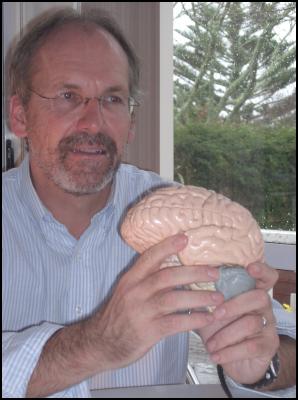Study To Train The Brains Of Young Drivers
Study To Train The Brains Of Young Drivers

Click to enlarge
Dr Robert Isler holding a model of the human brain. Photo credit: Sophie Isler.
Media Release: 15 August 2006
Study To Train The Brains Of Young Drivers
Waikato University and the AA Driver Education Foundation have announced they will conduct a study to evaluate a new training approach for young drivers. The aim of the study is to prove – or disprove – the benefits of combining practical training with lessons aimed at enhancing risk assessment and other higher-level skills.
“A driver is 19 times more likely to crash during their first six solo months, than during the first six months of driving when they were supervised,” says Dr Robert Isler, senior lecturer in psychology at the University of Waikato.
In 2004 drivers aged under 25 accounted for 30 per cent of road deaths and 30 per cent of road injuries. So why are young people – whose reaction times and learning capabilities are theoretically at their peak, and who have most recently obtained training – at such high risk of crashing their cars?
Dr Isler says “a primary factor is young people’s inability to adequately assess and respond to risk, behaviour that’s directly connected to brain maturity.”
“The brain’s frontal lobe is responsible for cognitive functions that control life-saving behaviour such as emotion regulation, hazard anticipation and risk management. Yet brain imaging studies show this lobe does not fully develop until drivers are 25.”
“International studies have shown functions like emotional regulation and hazard anticipation can change with proper training, and experience.”
The AA Driver Education Foundation and Waikato University are interested to learn how effective such training is. The study, known as the ‘double-blind Frontal Lobe Project’ will take place in Taupo from 22 September, with 72 participants. Half will provide the control group, half will turn up for two weeks of incentive-based training. Some will receive only cognitive training while others also receive teaching in practical skills. Teams of examiners will conduct blind evaluations at regular intervals. All participants, including the control group, will be followed up after six, 12 and 18 months to see which approach was most effective – and what learning each group has retained.
“Frontal lobe training is vital if young people are to appropriately apply the practical skills they’ve learned. This study could revolutionise driver training not just in New Zealand, but internationally,” says Dr Isler.
The Waikato University and AA Driver Education Foundation study is being supported by the Ministry of Transport and the Road Transport Industry Training Organisation.
ENDS


 University of Auckland: Protecting Young Minds With AI
University of Auckland: Protecting Young Minds With AI Greenpeace: Greenpeace Calls On Fonterra Investors To Consider Big Picture With Giant Puzzle
Greenpeace: Greenpeace Calls On Fonterra Investors To Consider Big Picture With Giant Puzzle Hugh Grant: How New Tech Helps Kids Love Soccer More
Hugh Grant: How New Tech Helps Kids Love Soccer More Bill Bennett: Download Weekly - 100% claim lands One New Zealand in criminal court action
Bill Bennett: Download Weekly - 100% claim lands One New Zealand in criminal court action FSCL: Woman Scammed Out Of $25,000 After Job Offer On LinkedIn
FSCL: Woman Scammed Out Of $25,000 After Job Offer On LinkedIn NIWA: Cheers To Crustaceans - New Species Named After Welly Brewery
NIWA: Cheers To Crustaceans - New Species Named After Welly Brewery



